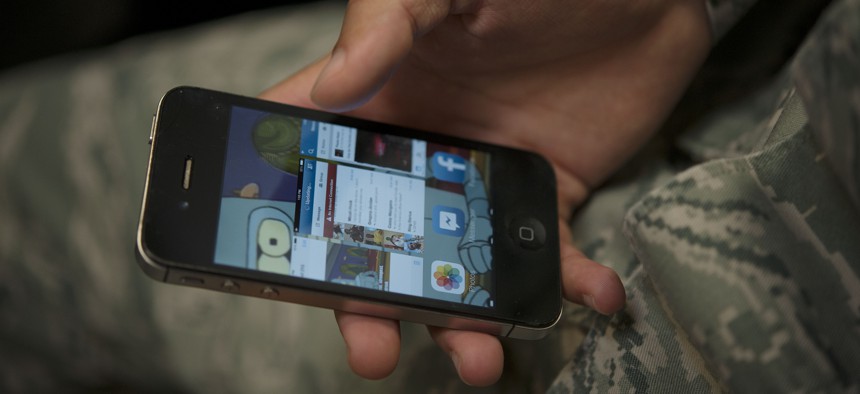
An airman scrolls through applications on a cellphone Jan. 31, 2014, at Incirlik Air Base, Turkey. U.S. Air Force / Senior Airman Nicole Sikorski
The US Military Just Partially Banned Geolocatable Cellphones. That's a Start.
The consequences of Internet-of-Things insecurity on national security should now be clear.
In January, researchers discovered that Strava, a “social network for athletes,” enabled anyone to track users wearing a FitBit or similar IoT device. This is a potential threat to individuals, but an even greater one to a military: by looking at Strava tracks around the globe, researchers could track large-scale troop movements and even identify secret military bases.
Now, it’s been revealed that the Polar fitness tracker was exposing user data as well. Researchers reportedly discovered 6,400 users in sensitive locations, “including the NSA, the White House, MI6 in London, and the Guantanamo Bay detention center in Cuba.” Even names were exposed, including officers at the French DGSE in Paris and the Russian GRU in Moscow. The researchers could even apparently trace—as explained in a disturbing report—the movement of a single intelligence officer to their home.
The Pentagon has begun to grasp the implications. On Aug. 3, Defense leaders issued a department-wide edict: “Effective immediately, Defense Department personnel are prohibited from using geolocation features and functionality on government and non-government-issued devices, applications, and services while in locations designated as operational areas.”
[The Pentagon defines an operational area as 'a location where military are operating for the purposes of a specific mission," Pentagon spokesperson Maj. Audricia Harris told Nextgov. Overseas military outposts, such as those used in the fight against ISIS, would fall under this umbrella, she said, but the Pentagon building would not.]
The consequences of IoT insecurity on national security should now be clear. From surveilling troop movements at scale to identifying and tracking individuals in sensitive positions—all through the public internet—the privacy protocols of IoT devices can put entire teams or organizations at risk.
Related: Strava’s Just the Start: The USMilitary’s Losing War Against Data Leakage
Related: Pentagon Warns CEOs: Protect Your Data or Lose Our Contracts
Related: The Next Wave of Cyberattacks Won’t Steal Data — They’ll Change It
As discussed in my forthcoming paper, this is symptomatic of a larger series of gaps in U.S. federal government policies on IoT privacy and security. The Department of Defense lacks robust and cohesive policies on when, where, and how active military personnel can use consumer IoT devices while on deployment. The Department of Homeland Security and the Department of Energy lack consensus on who handles security of the industrial Internet of Things, where IoT sensors and controllers interact with mechanical systems like electrical grids and industrial manufacturing plants. And virtually all federal agencies have no clear and robust policies on using consumer IoT devices within their own offices.
When IoT devices lack basic encryption, have default passwords, and constantly upload data to one another, to other IoT networks, and to the public internet, any privacy lapse can have potentially enormous effects on national security.
Conversations can be spied upon within offices and homes. Users can inadvertently have their names or home addresses leaked online. Military and intelligence officers could be tracked, virtually anywhere, by virtually anyone in the world through wearable devices. As the Pentagon’s Aug. 3 directive put it: “The rapidly evolving market of devices, applications, and services with geolocation capabilities presents a significant risk to the Department of Defense personnel on and off duty, and to our military operations globally. These geolocation capabilities can expose personal information, locations, routines, and numbers of Department personnel, and potentially create unintended security consequences and increased risk to the joint force and mission.” All it takes is an Internet connection.
Thus, U.S. federal agencies must develop clear and cohesive policies for consumer IoT device use in the “workplace,” whether a fitness tracker on a military base or a smart speaker in a conference room. In cases where consumer IoT device use is allowed, federal agencies should establish minimum privacy and security requirements for devices used by employees, addressing such questions as “what information do these devices collect?” and “how is that information transmitted and stored?” This should be coupled with required, relevant education on the Internet of Things itself, covering such topics as encryption and data collection.
Policymakers can use the Federal Acquisition Regulation to compel baseline privacy and security standards in IoT devices used by contractors, which should further safeguard against threats like the ones described above. Federal agencies should work with organizations like NIST to push baseline standards across industry and society as well. While these policy steps are neither a comprehensive list nor an absolute “solution,” they can combine with other approaches—like public-private partnerships—to guard against IoT privacy-propelled threats to national security.
NEXT STORY: How Trump Radicalized ICE



